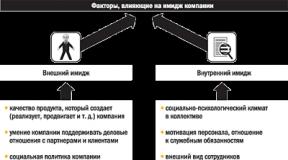What is the difference between phlebothrombosis and thrombophlebitis? Difference between thrombophlebitis and phlebothrombosis. Differences in treatment
Phlebothrombosis the formation in the lumen of the vein of a thrombus, fixed to the wall of the vein, completely or partially ("floating thrombus") obstructing the vessel with the addition of inflammatory changes in the venous wall.
Thrombophlebitis called inflammatory changes in the venous wall, followed by the formation of a thrombus in the lumen of the vein.
Etiology and pathogenesis (Virchow triad 1856):
changes in the inner wall of the vessel (trauma to the vascular wall, violation of the integrity of the endotheium, exposure of the subendothelial layer)
changes in blood composition (deficiency of coagulation inhibitors, disturbance in the fibrinolysis system, increase in blood viscosity)
slowing down blood flow (immobilization)
From the point of view of modern phlebology, there are no fundamental differences in the pathogenesis of thrombophlebitis and phlebothrombosis. With vein thrombosis, there are always inflammatory changes in the venous wall, and inflammation of the vein wall (phlebitis) is accompanied by its thrombosis. However, phlebologists, understanding the conventionality of such a division, use the term thrombophlebitis with lesions of the subcutaneous veins, and phlebothrombosis - deep veins. The only exceptions are cases of purulent fusion of thrombotic masses, which are extremely rare today, which can occur both in the superficial and deep venous systems.
Classification:
By etiology:
infectious;
allergic;
aseptic.
Distinguish with the flow:
Acute thrombophlebitis (the duration of the pathological process is up to 1 month);
Subacute thrombophlebitis (duration of clinical manifestations from 1 to 2 months);
Chronic thrombophlebitis, or post-thrombophlebitic syndrome (a long-term pathological process in the venous system due to the postponed thrombophlebitis, which develops over a period of more than 2-3 months).
By the nature of the inflammation, thrombophlebitis is distinguished into:
Not purulent.
According to the localization of the pathological process, they are distinguished:
Thrombophlebitis of superficial veins;
Deep vein thrombophlebitis.
Clinical picture:
Deep vein thrombophlebitis is an independent or complication of superficial thrombophlebitis. Most often, the deep veins of the lower leg are affected, then the popliteal and overlying veins of the thigh. Deep vein thrombosis is always a serious and potentially dangerous disease. Symptoms of leg vein lesions: sudden onset, bursting pain and induration along the deep veins, local increase in body temperature. Swelling, a feeling of fullness, distention, heat and cramps in the calf muscles develops. Pain, heaviness and the sensations just mentioned increase sharply when lowering the leg. The volume of the corresponding part of the limb increases. Unable to stand up. The skin on the feet, fingers, lower leg becomes slightly shiny due to edema and pale. The pattern of the cutaneous and saphenous veins increases sharply, sometimes they expand noticeably.
The defeat of the popliteal and especially the femoral vein proceeds much more severely than thrombophlebitis of the lower leg. Swelling of the leg increases rapidly. The skin becomes hot, bluish. Vascular spasm develops, which is determined by the state of the pulse and changes in skin temperature. Severe pain appears along the affected veins of the lower leg and thigh. Swelling and limited movement in knee joint... The tissues are tense along the thrombosed vein, the skin is hot to the touch, swollen. There is a sharp pain along the neurovascular bundle. The saphenous veins are dilated and clearly visible against the background of cyanotic and slightly reddened skin.
With the pelvic-femoral form of thrombophlebitis, that is, with the involvement of the iliac veins, the inferior vena cava in the process, especially severe pains are localized in the lower leg, thigh and buttock, the lower half of the abdominal wall. Intestinal and bladder functions are impaired. A severe general reaction of the body develops with a high body temperature, leukocytosis, increased ESR, chills, etc. There comes a swelling of the leg, and sometimes of the genitals, perineum, lower part of the anterior abdominal wall.
Distinguish the following clinical options phlebothrombosis of deep veins.
White painful phlegmas: the disease is accompanied by a sharp spasm of arterial vessels. Severe salt syndrome, the limb is pale, cold to the touch, the pulsation of peripheral vessels is absent or sharply weakened. Difficult to differentiate from acute disorders of arterial circulation.
Blue pain phlegmas- the most severe form of phlebothrombosis. Almost all venous vessels of the limb are affected with a sharp violation of venous blood flow and the rapid development of limb gangrene.
Diagnostics:
Radionuclide study with labeled fibrinogen (searches for a hidden source of thrombus formation. Allows to identify asymptomatic thrombosis in various pools).
Duplex scanning (two-dimensional image of blood vessels with the ability to assess the state of the vascular wall, the nature and speed of blood flow through them).
Ultrasound angioscanning (allows you to assess the condition of the vein, surrounding tissues, determine the localization of the thrombus, its length and the nature of thrombosis).
Treatment
Conservative:
The use of elastic compression of the affected limb, the use of local hypothermia at the call of the projection of the vascular bundle, which helps to subside phlebitis and reduce pain.
Anticoagulant therapy (direct - heparin (about 7 days), indirect - antivitamin K (on the 3rd day)).
Surgical:
Endovascular surgery (percutaneous implantation of cava-wire filters. In a sleeve about 3 mm in diameter through the left subclavian or right jugular vein set distal to the orifices of the renal veins).
Plication of the inferior vena cava (suturing the lumen of the inferior vena cava below the mouths of the renal veins with a U-shaped suture so that the lumen of the vein is divided into a number of canals. A diameter of about 5 mm, sufficient for the outflow of venous blood, but not allowing large thromboemboli to pass through).
Vein ligation (prevents embolization of the pulmonary vascular bed. Those veins are ligated, the cessation of blood flow through which, does not cause serious violations of venous outflow).
Palliative thromboectomy (attempts to completely remove thrombotic masses from the venous bed).
Complications. Thromboembolism pulmonary artery, myoglobinuria, hypovolemic shock, hyperkalemia, consumption coagulopathy. In the long term, post-thrombophpebitic syndrome develops.
Prophylaxis... Elastic bandaging of the limb during and after surgery, childbirth, use of the veins of the lower extremities for infusion should be avoided. Getting up early, therapeutic exercises after surgery.
These two serious illness characterized by the fact that in the process of a person's life they form blood clots in the lumens of venous vessels, thereby changing the movement of blood in them. Therefore, it is important when diagnosing pathologies such as thrombophlebitis and thrombosis, the difference in symptoms.
What is called thrombophlebitis?
Thrombophlebitis is an inflammatory process that takes place in the walls of blood vessels and leads to the formation of blood clots in the venous lumen. It can be localized in the lower extremities, upper, cervical and thoracic regions of the body. In the system of the human body, there is a network of veins that are located just below the surface of the skin and below, in deeper layers.
Based on this, phlebothrombosis is distinguished:
- deep veins lower limbs;
- superficial veins.
The reasons why phlebothrombosis can occur can be as follows:
- hereditary disposition to thrombus formation and thrombophilia conditions;
- trauma to the walls of veins and blood vessels by chemical, pharmacological or microbial factors, and as a result - their inflammation;
- varicose veins, which reduces the speed of blood flow through the veins, leading to congestion;
- any surgical intervention;
- diseases of the lungs and cardiovascular system;
- forced states of immobility;
- an infection brought inside the hematopoietic system.
Symptoms most often make themselves felt when the disease has already spread to sufficiently large areas in the body.
V initial stages it hardly manifests itself in any way. The main danger is that a blood clot can come off at any time and move freely through the veins. It is impossible to predict where he will go.
The most dangerous thing in this case is the ingress of a blood clot into the vessels of the lungs, which can lead to blockage of the respiratory arteries. In addition, the danger also lies in the fact that a blood clot can grow and block the main vein, which will already lead to chronic venous insufficiency and significantly complicate treatment.
In addition, there are a number of circumstances that may contribute to the development of this disease:
- diabetes mellitus of all types;
- oncological diseases;
- obesity of all degrees;
- use hormonal drugs and contraceptives;
- taking steroid drugs;
- herbs;
- pregnancy or menopause;
- benign neoplasms in the pelvic organs.
The fact that the inflammatory process began in vascular system, the following main symptoms of phlebothrombosis may indicate:
- slight swelling of the legs;
- calf pain;
- burning sensation and heaviness in the legs;
- slight redness of the skin;
- visible expansion of the subcutaneous vessels;
With these symptoms, most often they do not turn to specialists for help. They visit the clinic when more serious symptoms appear - severe swelling, a bluish skin tone, or in a completely neglected condition with already blackened legs. Then the treatment process becomes much more complicated and increases in time.
What is called thrombosis?
Vein thrombosis of the lower extremities is a serious disease that is quite insidious, because its course is almost asymptomatic.
This is a kind of malfunction in the process of the system of blood and lymph vessels, which causes various disturbances in blood flow.
This disease is essentially the next stage in the development of thrombophlebitis. Its main danger lies in the fact that it affects the deep veins of the body. Namely, these veins directly communicate with the heart and pulmonary arteries.
Most often, the place of localization of pathology is the calf muscles of the legs. And according to the observations of specialists, the left leg is usually susceptible to this disease.
There are also a number of factors that can contribute to the development of this disease:
- surgical interventions varying degrees difficulties;
- trauma;
- pregnancy and childbirth;
- various allergic reactions;
- purulent and septic diseases.
With this disease, blood clots form in the veins, which begins to interfere with normal blood circulation. Such clots are able to completely close the lumen of the vein and, in the end, come off. In those places where there was a blockage due to impaired blood circulation, tissue may begin to die off.
When a blood clot breaks off from a vessel, it can reach the heart, lungs or other organs, causing a stroke, heart attack or thromboembolism, all of which is fraught with paralysis or death.
The symptoms of this venous disorder are mostly asymptomatic, and this is where the danger lies.
However, there are a number of signs, paying attention to which you can take the necessary measures in time.
- change in skin tone at the location of the clot;
- swelling of the legs. It can be located on the lower leg, ankle, thigh, or over the entire leg;
- short-term pain;
- feeling of stiffness;
- severity;
- feeling of fullness of muscles;
As the disease progresses to the maximum, these symptoms gradually become brighter and more acute. The provocateur is stagnation in the vein, below the site of thrombus formation.
If the vein is completely closed, the swelling will increase even more, completely disrupting the normal metabolism. This can lead to gangrene.
What is the difference between thrombosis and thrombophlebitis?
There is a big difference between these two diseases, especially if you analyze each of them separately.
Thrombosis is characterized by:
- damage to venous vessels that are close to the surface of the skin;
- arbitrary development, regardless of inflammation or damage to the vessel;
- the primary violation of the composition of the blood, leading to the formation of a blood clot - increased coagulability;
- easy swelling;
- mild pain due to physical exertion;
- numerous formation of blood clots with minor inflammatory processes;
- spontaneous pain;
Due to the mild severity of symptoms for medical help are most often addressed at a critical stage.
Thrombophlebitis is characterized by:
- damage to the vessels of deep tissues;
- development in case of damage to the venous wall of the inflammatory process in it. Because of this, a blood clot begins to form. Varicose veins may be a harbinger of this;
- danger to blood vessels, which are most exposed to various loads;
- sharp painful manifestations while walking or strenuous physical exertion;
- a feeling of fullness and heaviness in the limbs;
- changes in the skin to a bluish tint, severe skin elongation;
- an increase in temperature in the affected limbs or throughout the body up to 39 degrees;
- inflammatory processes predominant over the formation of blood clots in the vessels;
- swelling, significantly reducing the ability to move;
- pronounced, protruding vessels on the legs;
- the likelihood of no pulse in the arteries of the extremities;
- complaints about general weakness with deterioration of health;
- chills;
- frequent headaches;
The pathogenesis of the course of these two diseases is in many ways similar and even interrelated, especially the process of blood clots formation on the mucous membranes of blood vessels. But the main difference is which veins are affected by this disease - superficial or deep. Otherwise, there are no significant differences in these diseases.
In order to find out how thrombosis differs from thrombophlebitis, it is necessary to consider the specifics of the development of these pathologies. Mostly these diseases are considered synonyms, which is completely wrong. Despite the same etiology, the diseases presented are completely different. They differ in the localization of the inflammatory process, symptoms, and treatment regimens.
Despite the fact that thrombosis and thrombophlebitis are different diseases, the causes of their occurrence are the same.
The following negative factors affect the functionality of the vessels:- functional impairment nervous system and endocrine glands;
- failure of the hormonal background;
- the appearance of all sorts of neoplasms;
- diseases of the cardiovascular system, changes in blood composition;
- damage to the walls of blood vessels due to an incorrect injection, as well as the constant installation of a catheter in the same place;
- allergic reaction;
- surgery performed in the pelvic area, as well as abdominal cavity, the hip joint (during the process, the vessels may be affected);
- inflammatory process, accompanied by the formation of pus;
- improper nutrition;
- bad habits (especially smoking, which has a negative effect on blood vessels);
- violation of metabolic processes in the body;
- pregnancy and the birth of a baby.
All these reasons negatively affect not only the state of blood vessels, but also the composition of the blood. Failure to treat vein diseases in a timely manner can cause serious complications. Some of them are fatal.
Many patients are interested in: thrombosis and thrombophlebitis - what is the difference? Thrombophlebitis is an inflammation of the vessel walls, which is characterized by the appearance of blood clots inside. Most often, it develops as a result of untreated varicose veins or chronic venous insufficiency. The disease often recurs, progresses, and also causes serious consequences. Without proper therapy, pulmonary embolism may occur, as well as blood poisoning.
According to the development and localization of vascular damage, thrombophlebitis has the following features:- It develops in the superficial veins that are under the skin.
- Most often, blood clots form in the affected and deformed vessels.
- Thrombophlebitis is much easier to diagnose than thrombosis. The lesion is characterized by the presence of severe inflammation in the vein, so the patient has specific symptoms.
Thrombosis is a more dangerous disease. It most often develops in bedridden patients who cannot move independently. The main danger of the presented pathology is that it leads to thromboembolism of the branches of the pulmonary artery. And this can hasten the death of the patient.
Thrombosis differs from thrombophlebitis in the following features:- Pathology predominantly affects deep vessels.
- Blood clots form not in deformed, but normal veins.
- A disease occurs due to a violation of the rheological and coagulation properties of the blood. Damage to blood vessels is irrelevant here.
- Thrombosis is not accompanied by inflammation, therefore, the symptoms of this pathology are poorly expressed. That is, the diagnosis of the disease becomes more complicated.

Despite the fact that pathologies have almost the same causes of occurrence, they manifest themselves in different ways.
Thrombosis is characterized by the following symptoms:- the patient has sudden severe pain in the affected limb;
- discomfort often intensifies after physical exercise or walking;
- with the development of the disease, the patient has tissue edema, and there is also a feeling of leg spreading, heaviness;
- the skin around the affected area becomes shiny, strongly taut, cyanotic;
- the vessels are dilated and tense, which becomes noticeable quickly enough;
- the patient's temperature of the affected leg rises by several degrees;
- most often, the pulsation in the affected vessel is felt very weakly or completely absent.
As for thrombophlebitis, in the acute period, the pathology is characterized by pulling pain sensations that are localized in the area of the blocked vein. The affected vessel becomes dense, the leg swells, and the patient's movements are difficult. In the course of where the vessel is thrombosed, there is swelling, redness and infiltration of soft tissues.
Unlike thrombosis, with thrombophlebitis, the temperature of the diseased leg does not change, as does the pulsation of the vessels.

Therapy for these diseases also has its own characteristics. For example, with thrombophlebitis, the patient does not need to be hospitalized. All therapeutic measures can be performed at home. The patient is advised to adhere to bed rest, while the affected limb should be elevated to improve blood flow.
To treat the legs, warm compresses are used, as well as antiseptics (Dimexide). To eliminate the inflammatory process, the doctor may prescribe non-steroidal anti-inflammatory drugs, both in tablets and in the form of a cream or gel.
For the treatment of deep vein thrombosis, the patient will have to be in the hospital. Treatment is carried out with injections of low molecular weight heparin. Thanks to this medicine, specialists can prevent the existing blood clot from growing further, as well as the formation of new ones. Correction of rheological parameters of blood is obligatory.
Thrombosis can be treated with surgery. Specialists remove the blood clot that blocks the vessel, or install a special filter in the inferior vena cava. Treatment activities are individual in each case and largely depend on general condition the patient, as well as the characteristics of his body.
Now it is clear what is the difference between thrombosis and thrombophlebitis. The only rule that unites these pathologies is the timeliness of diagnosis and treatment. Only complex therapy is able to eliminate the disease and improve a person's life.
Thrombophlebitis and thrombosis can be distinguished by the location of the affected area. The development of thrombophlebitis occurs in the veins running directly under the skin, and thrombosis usually occurs in the deep venous vessels.
With the development of thrombophlebitis, blood clots appear in deformed veins, and thrombosis can occur in any venous vessel that does not have any changes.
Thrombophlebitis and phlebothrombosis appear on the walls of deep veins. But the first can develop on the superficial vein, and the second appears only on the walls of deep veins.
Thrombophlebitis appears when varicose veins venous vessels, with damage to the venous wall, when there is a violation of the outflow of blood plasma from the limb, a slowdown in blood circulation. This forms a blood clot that closes the lumen in the vein.
Phlebothrombosis occurs on a non-inflamed, deeply buried venous canal, while the vein itself remains unchanged. A thrombus with a loose structure forms on the wall of the vessel. It comes off easily and can move with the blood stream, which leads to the development of thromboembolism. If the vein is varicosely dilated, then thrombophlebitis may appear along with phlebothrombosis. The first gives full symptoms of the lesion, and the second proceeds without any symptoms.
Usually, pathological changes in the venous canals begin to develop due to varicose veins themselves, lesions interior walls vessels due to various injuries, the development of infection and many other reasons. All this slows down blood circulation in the venous canals, and stagnation leads to inflammatory processes. Blood clots appear, which quickly harden, forming blood clots. This leads to complete stagnation of blood, inflammation of the soft tissues of the legs or arms.
Unlike thrombophlebitis, thrombosis is considered more dangerous, since blood clots can develop with it due to the slightest damage to the vein. And phlebothrombosis with thrombophlebitis appears due to changes in the properties of the blood itself.
Thrombosis can develop in non-inflamed venous vessels, and the appearance of thrombophlebitis is almost always associated with varicose veins. With thrombosis, the symptomatology of the disease is not as pronounced as it happens when thrombophlebitis appears, which is much easier to identify, since it proceeds with noticeable inflammatory processes at the local and general levels.
Factors affecting the appearance of pathologies
The difference in the reasons for the development of a particular disease on the veins of the extremities is small. With both types of ailments, blood clots form. Regardless of the location of any of the pathologies, the main reasons for their appearance are:
- the development of varicose ailments;
- various vascular diseases;
- trauma to the walls of the vein;
- pathology with a change in the composition of the blood, an increase in its coagulability;
- slowdown and stagnation in the bloodstream.
Usually, diseases can lead to such conditions of a person. endocrine system, various tumors, chronic ailments of the cardiovascular system, infections (both local and general). Lesions can appear due to blood diseases, allergies, and neurotrophic disorders. The vein can be damaged during injection or during long periods of catheterization, pelvic and lower abdominal surgery. Often, local inflammation or a purulent process plays an important role in the appearance of ailments in the veins. Thrombosis or thrombophlebitis can be caused by metabolic disorders, inappropriate diet, smoking and drunkenness, disruptions in the hormonal system. In women, pregnancy, abortion, childbirth can affect the appearance of venous diseases.
Thrombophlebitis can occur due to deformation of the veins that occurs with excessive loads on the hip joints, for example, with prolonged exposure to large physical activity(weight lifting). But this also happens with low mobility of the patient, sedentary work, when there is stagnation of blood in the veins of the legs.
Symptoms of various venous lesions
Thrombosis differs from thrombophlebitis and phlebothrombosis and its own characteristics. With the last two ailments, the patient develops pain at the site of the lesion on the limb. But it is not constant, although it can sharply increase when walking, standing for a long time or lifting weights. After this, swelling of the tissues, heaviness in the legs may appear. The skin around the site affected by a blood clot turns blue, stretches strongly, gives off an unnatural shine. Tense and dilated veins can be seen 3-4 days after the formation of blood clots.
The temperature of the skin on the legs can increase by two degrees. In some patients, this causes a general rise in body temperature. The pulsation of the artery in the affected leg may be weakened or absent altogether.
If deep vein or calf thrombosis begins, the symptoms are usually erased, since in most cases a sign of the disease is a small swelling in the ankle joint and a slight soreness in the calves with physical exertion.
Acute thrombophlebitis on the superficial veins gives a pulling pain, which is localized at the site of the development of the thrombus itself. The diseased vein thickens and begins to protrude above the surface of the skin. In this case, the pulsation in the arteries of the leg does not disappear, as it happens with thrombosis. It is difficult for the patient to move the leg; swelling is recorded on the limb. Swelling appears along the affected vein. There is noticeable hyperemia on soft tissues, infiltration. The skin at the site of the thrombus turns blue. With varicose veins, it becomes very tense. During the feeling of the affected area, the patient feels severe pain.
Thrombophlebitis is accompanied by following signs inflammation: the patient begins sharp deterioration feeling, he complains of general weakness, pain in the head, he is tormented by chills. A significant increase in temperature is possible - up to 38-40 ° C.
With the development of thrombophlebitis in the deep veins, uniform edema is observed on the lower leg and foot. The soreness is dull. It can increase dramatically when you press on the calves or the bend of the foot. It is difficult for the patient to walk, and in some periods of time the pain intensifies so much that the person cannot step on his foot.
If at least one of the above symptoms occurs, you should seek help from a doctor of the appropriate specialty (phlebologist).
The patient will undergo a medical examination and, in the presence of any of the described vein diseases, will begin to treat the disease. It is better not to self-medicate because of possible complications.
Many patients think that there is no difference between phlebothrombosis and thrombophlebitis, considering them synonymous with one pathology. In reality, these are completely different diseases, although they have a similar etiology. The differences between these two pathologies are noticeable upon closer examination.
Description of diseases
The main distinguishing feature of phlebothrombosis and thrombophlebitis is the location of the pathology. Thrombophlebitis is localized in the superficial vein, and phlebothrombosis affects deep venous vessels. Another difference is the condition of the veins. With thrombophlebitis, blockage occurs only in damaged vessels, then with phlebothrombosis, healthy vessels are affected.
Vein pathologies can develop due to varicose veins, mechanical damage, infection and other factors. In any case, there is a slowdown in blood flow through the vessels, which causes their inflammation and the formation of clots (blood clots).
It is phlebothrombosis that is the most dangerous vascular pathology, since the formation of blood clots occurs due to a change in the coagulation properties of blood, and not as a result of their damage, as is the case with thrombophlebitis.
The difference between phlebothrombosis and thrombophlebitis is that in the first pathology, the disorder manifests itself in a healthy vein. This means that the symptoms are weak or absent altogether.
Reasons for development
The etiology of these two diseases is the same. Thrombus formation occurs as a result of many factors and in most cases develops against the background of violations:
- Phlebeurysm;
- Pathology of blood flow through the veins;
- Injury to the walls of blood vessels;
- Deviation from the norm of the composition of the blood;
- Reducing the speed of blood flow.
Such changes in blood vessels can be caused by a number of reasons affecting the body. These include:
- Disorders of the endocrine system;
- Active growth of malignant neoplasms;
- Chronic vascular disease;
- Infectious processes in the body;
- Blood composition disorders;
- Errors in injection, suggesting trauma to the vein;
- Disorders of the nervous system;
- Frequent placement of the catheter in the same area;
- Surgery affecting the pelvic and abdominal region;
- Pregnancy and childbirth;
- Artificial termination of pregnancy;
- Hormonal imbalance;
- Improper diet or strict diets;
- Bad habits;
- Metabolic disorders.
Thrombophlebitis affects those vessels that bear the greatest load. Therefore, most often the lower extremities suffer from this ailment, which account for the entire load of the body, especially if a person is in motion all the time or lifts weights.
Not only an overabundance, but also a lack of movement becomes the cause of the development of thrombosis. Moderate physical activity is the optimal solution.
Signs and symptoms
The main symptom of phlebothrombosis is acute pain in the limb where the pathological process began. At the same time, it is not permanent, but manifests itself, first of all, while walking, carrying weights and other situations when the greatest load is on the legs.
Also, this condition is characterized by swelling of soft tissues, which is accompanied by a feeling of heaviness and fullness in the legs. The skin around the affected area tightens and becomes bluish. The expansion and blockage of the vein becomes noticeable only a few days after the formation of a blood clot.
The temperature of the affected leg is usually 2 ° C higher than the general body temperature. The pulsation of the artery in the injured leg may remain unchanged, but most often it is reduced or completely invisible.
If a person suffers from thrombophlebitis, clinical picture deep vein lesions will be virtually erased. In this case, the only manifestation may be a large swelling at the location of the ankle joint, as well as minor pain in the gastrocnemius muscle.
The acute form of thrombophlebitis manifests itself as a pulling pain that occurs in the area of the affected vein. The vessel itself has a seal and can protrude above the skin. Unlike phlebothrombosis, with this pathology, the pulsation in the vein will be palpable and normal.
Signs of thrombophlebitis may be accompanied by symptoms of an inflammatory process in the affected limb. Which include:
- General impairment of well-being;
- Chills;
- Headache;
- Increased body temperature;
- Weakness.
With the development of thrombophlebitis, there is a uniform development of swelling of the leg and foot. Painful sensations are dull in nature, which intensify when bending the leg or pressing on the affected area.
There are a lot of differences between these two diseases, however, if the slightest suspicion or a similar symptom arises, it is necessary to consult a doctor for diagnosis.
Treatment
When diagnosing phlebothrombosis, complex treatment is prescribed. Conservative methods include medication and special procedures. Namely:
- Reception of anticoagulants normalizes blood viscosity.
- Disaggregants minimize clotting and blood clots.
- Phlebotonics improve blood flow and normalize vascular tone.
- Immobilization helps to keep the affected limb in one position.
- Compression with elastic bandages is necessary during the recovery phase.
- A diet that contains a minimum amount of cholesterol.
Depending on the severity of the development of the disease, surgery... It consists in excision of the vein and removal of its damaged area.
In the case of diagnosing thrombophlebitis, complex therapy is also prescribed, which consists in following procedures and preparations:
- Fixation of the injured limb with a Beller splint.
- Compression clothing, as well as fixation of the foot with elastic bandages.
- Anticoagulant drugs.
- Anti-inflammatory drugs.
- A small amount of glucocorticoids.
Thrombophlebitis and phlebothrombosis are treatable. Its favorable outcome is most likely with the timely detection of pathology. And attention to your health plays an important role in this case.
What is the difference between phlebothrombosis and thrombophlebitis?
Among physicians, there is no single view of whether thrombophlebitis and phlebothrombosis should be considered as different pathologies, or whether they should be considered one disease. Concerning clinical practice, then three names are used here, denoting the defeat of the venous system by thrombi: "venous thrombosis" (indicating localization), "phlebothrombosis" and "thrombophlebitis".
There is no controversy among physicians regarding venous thrombosis - this term is used to refer to the entire group of diseases associated with blood clots. But there is confusion about the other two names: some experts consider the names to be synonyms, others as different pathologies that have fundamental differences.
Differences between diseases
More recently, it was believed that with thrombophlebitis, pathology first covers the venous wall and only then does a thrombus form. Moreover, the thrombus is tightly fixed on the wall, and therefore the likelihood of its separation with subsequent embolization is practically reduced to zero. This view of the problem was axiomatic - based on this, therapeutic tactics were built.
Phlebothrombosis was considered as a process in which a thrombus occurs without preliminary changes in the venous wall. It was this fact that explained the almost unsystematic course of phlebothrombosis in most cases. Unlike thrombophlebitis, in the case of phlebothrombosis, there is a high probability of a thrombus rupture, since the blood clot is fixed to the venous wall less reliably.
The above concepts of thrombophlebitis and phlebothrombosis dominated for many years - they developed back in the days when operations on thrombosed veins were quite rare. However, as surgeons gained experience, the old views turned out to be inconsistent from the evidence point of view: it turned out that there were no fundamental differences between the pathogenesis of both pathologies considered in this article.
The inflammatory process in the venous wall (most often aseptic) leads to the formation of blood clots, and the occurrence of a thrombus is associated with a reaction of the endothelium and phlebitis.
Thus, both processes (phlebitis and thrombosis) are interrelated, and the reasoning about which of these pathologies is primary resembles the dispute about the primacy of the egg or chicken.
With sufficiently limited symptoms of phlebothrombosis during surgical intervention at the site of primary thrombus formation, pronounced phlebitis and changes of an inflammatory nature in the paravasal tissues are found. In a typical thrombophlebitis, when the inflammatory process is obvious, the proximal part of the thrombus can be located completely free in the vascular lumen, and the manifestations of phlebitis will become apparent only after a few days.
Thus, based on classical concepts, the same patient can simultaneously have both thrombophlebitis and phlebothrombosis in different parts of the venous system.
Most phlebologists at the moment are aware of the conventionality of the division, in which phlebothrombosis and thrombophlebitis are considered different diseases. Therefore, experts use the term "thrombophlebitis" when they talk about the defeat of the saphenous veins, and by "phlebothrombosis" they mean pathology in the deep veins. In the case of phlebothrombosis, the symptomatology is almost invisible, since the vein is located at a depth - in the fascial case, and the manifestations of the disease can only be judged by violations of the outflow from the veins (swelling, pain syndrome). It should be noted that macroscopic and microscopic transformations in the vein wall caused by the inflammatory process are present both in the case of deep vein thrombosis and in the case of thrombophlebitis. The only exception is the currently very rare purulent fusion of blood clots, which can occur both in superficial veins and in deep ones.
From the point of view of the clinical approach acute thrombophlebitis especially dangerous, since when a thrombus is localized in the saphenous veins, it can go into the deep veins of the legs with a high probability of serious complications. Among the consequences of this development of events is chronic venous insufficiency, trophic ulcers, myocardial infarction and even death.
At the present stage, many doctors associate thrombophlebitis with varicose veins. This opinion is especially common if the patient has symptoms corresponding to varicose veins - venous nodes with pronounced varicose changes.
Among general practitioners, there is such a view of phlebothrombosis and thrombophlebitis: the latter, unlike deep vein damage, is not a serious pathology. This approach is due to what was mentioned above - the perception of two names as different pathological processes, although in practice it has been proven that this is not so.
The formation of blood clots in the saphenous veins may well be combined with a similar pathology in the deep veins. This possibility exists due to the spread of the process through the fistulas, perforating veins, as well as in connection with the simultaneous formation of a thrombus. According to statistics,% of patients with thrombophlebitis have blood clots in the deep veins.
In most cases, the spread of thrombosis to deep veins can be avoided. However, if time is lost, pathology transforms into a completely different format. Even if there is no pulmonary embolism, phlebothrombosis will require complex, long-term treatment (often throughout life).
Features of the development and treatment of phlebothrombosis
Phlebothrombosis (deep vein thrombosis) is a pathological process in which blood clots form in the bloodstream, which are fixed on the veins.
Most often, the disease is associated with an increase in blood density and impaired blood flow, which leads to thrombosis. The thrombus is fixed on the venous wall. Moreover, in the first 5-7 days, the blood clot is held very unreliably, which creates an increased danger of its separation with the possibility of pulmonary embolism.
Causes of the disease
The causes of phlebothrombosis can be roughly divided into three groups (the so-called Virchow triad):
- Damage to the venous wall (without rupture). In this case, the body activates a mechanism that inhibits bleeding. As a result, the volume of platelets increases sharply, and prostacyclin (prevents platelets from connecting to each other), on the contrary, becomes less. Blood clots are easily formed in the blood, which is altered by the shape composition.
- Blood clotting disorder (thrombophilia). It is also possible to decrease the activity of factors that counteract clotting (hypercoagulability). The pathological process can be started both under the influence of external factors and as a result of failures in the body itself (for example, in the case of an excess of adrenaline).
- Violation of the nature of blood flow. Too slow blood flow, as well as turbulent, provokes the formation of blood clots.
Any of the above reasons is sufficient for the development of thrombosis. All other causes are secondary, but may have an additional predisposing significance. Among the secondary causes of thrombosis are the following:
- genetic predisposition;
- autoimmune diseases;
- oncological diseases;
- a long period of immobilization (bed rest, sedentary work, constant flights in an uncomfortable position);
- trauma (surgery, bruises, fractures);
- bad habits (drugs, alcohol, tobacco).
Symptoms
The symptomatology of phlebothrombosis is most often mild. This is due to the fact that the vessels located deep in the lower extremities are affected.
A system of tests is used to detect the disease:
- Homans symptom. This test can be used to assess the patency of the deep veins in the lower leg. For examination, the patient lies on his back, bends the knees and then flexes the ankle to the back. If pain occurs in the calf muscle, the symptom test is positive.
- Payr's symptom. For the test, the dorsum of the ankle is palpated. Painful sensations on palpation indicate a positive test result.
- Lowenberg's symptom. A cuff of a special device - a sphygmomanometer - is applied to the lower leg. Further, air is injected into the cuff to a level in millimeters of mercury. If pain occurs, the symptom test is positive.
- Pratt's symptom. A positive result for a symptom is noted in the case of a clear manifestation of the venous network on the lower limb.
- Sperling's symptom. The test is positive if the skin is pale with a bluish tinge.
There are a number of additional secondary signs of phlebothrombosis:
- increased fatigue;
- violations heart rate, tachycardia;
- increase in body temperature in degrees;
- increased local temperature in certain areas of the lower extremities;
- pulling, bursting pain(usually become more intense in upright position body).
Classification
Deep vein thrombosis is classified according to a number of signs (localization, degree of development, type of thrombus). In turn, such a parameter as localization is also heterogeneous and has its own classification:
- phlebothrombosis in the vessels associated with the inferior vena cava (ileofemoral, muscle veins of the leg, cavaileofemoral, the trunk of the inferior vena cava);
- phlebothrombosis in the vessels associated with the superior vena cava (vein trunk, anonymous veins, azygos veins, complete thrombosis of the upper limb).
With all this, most often, according to localization, phlebothrombosis is divided into 4 groups:
According to the degree of development, the disease is divided into three types:
- acute thrombosis (development period - up to 2 weeks);
- subacute (from 2 weeks to 2 months);
- chronic (over 2 months).
According to the type of blood clot, there is the following classification:
- occlusive blood clots (stretched along the vein);
- non-occlusive blood clots (parietal);
- floating (attached to the vein only in a small area, and therefore can always come off);
- embologenous (mobile).
Deep vein thrombosis can lead to dangerous complications, including:
- post-thrombotic syndrome and chronic venous insufficiency;
- trophic ulcers;
- pulmonary embolism (can lead to heart attack or even death).
Diagnostics
Diagnostic measures begin with examining the patient and taking anamnesis. Further, the doctor prescribes a set of laboratory and instrumental studies:
- TEG - finding out the level of blood coagulability using graphics;
- APTT (activated partial thromboplastin time) - study of the internal and general blood coagulation pathway;
- thrombin production test;
- general blood analysis;
- ultrasound techniques (coloring elements can be used);
- venography (to assess the condition of the venous network and find a thrombus);
- magnetic resonance imaging (allows you to see deep veins);
- radioisotope scintigraphy.
Timely and accurate diagnosis allows effective treatment and avoids dangerous complications of the disease.
Treatment
To help the patient can be used as conservative methods and surgery. The specific treatment tactics are determined by the doctor, based on the stage of development of the pathological process and the general condition of the patient.
Acute deep vein thrombosis may require hospitalization. This condition is accompanied by severe swelling, pain syndrome bursting character, cyanosis of the skin and high body temperature.
In conservative therapy, the following are used:
- anticoagulants (needed to reduce blood density);
- phlebotonic drugs (improve vascular tone, which allows you to optimize blood flow);
- disaggregating agents (prevent platelets from sticking together);
- anti-inflammatory drugs (usually nonsteroidal drugs are used);
- tightening (compression) knitwear or elastic bandages (especially important in the recovery phase after the treatment of thrombosis);
- the location of the lower limbs in an elevated position (above the level of the heart);
- a diet with a minimum cholesterol content.
If conservative methods do not give the desired result, treatment of phlebothrombosis with surgical methods can be applied. Indications for surgery include a high probability of pulmonary embolism, gangrene, and purulent course of the disease.
The following surgical techniques are used:
- Excision of the affected vein. In the case of large veins, prosthetics can be performed. However, preference is given to shortening the vein (if possible).
- Partial occlusion. This technique consists in reducing venous patency by using a special clamp. Occlusion is used to prevent pulmonary embolism.
- Endovascular surgery. In this case, a coil is inserted into the vein through a catheter, which blocks the passage for large blood clots.
Prophylaxis
Preventive measures are reduced to creating conditions under which the likelihood stagnation or high blood viscosity will be minimized.
- organization of healthy food;
- wearing slimming underwear;
- reasonable physical activity (walking, swimming, remedial gymnastics);
- regular check-ups with a phlebologist.
Venous pathologies pose a danger to the patient and require serious complex treatment... If you have even the smallest symptoms, you should consult your doctor.
All information on the site is provided for informational purposes only. Always consult your doctor before applying any recommendations. Full or partial copying of information from the site without indicating an active link to it is prohibited. oblivki
Deep vein thrombosis of the lower extremities (phlebothrombosis)
A pathological condition manifested by the formation of blood clots with partial inflammation of the venous wall and impaired patency of the lumen of the vein is called phlebothrombosis. In the medical literature, everyday life and among specialists, it is found under a different name - deep vein thrombosis of the lower extremities. The relevance of the topic will not raise doubts among anyone due to the severity of the manifestations and the danger of complications of this disease. More often women of reproductive age are ill. The young age group also predominates among men. It is important to consider the correct terminology in relation to this pathological condition. This is due to the fact that in most cases thrombosis is called thrombophlebitis, which is not entirely correct.
Phlebothrombosis and thrombophlebitis, what is the difference
It would seem that there is nothing to understand. But in fact, these are two completely different diseases. Common to them is only a pathogenetic basis, which is the formation of blood clots against the background of an inflamed venous wall. The difference is that with thrombophlebitis, the process is localized in the superficial veins, and with phlebothrombosis, deep veins are affected. Depends on it clinical manifestations, complications and treatment of these conditions. Patient management tactics are fundamentally different.
With thrombophlebitis, inflammatory changes prevail over the formation of blood clots. Deep vein thrombosis of the lower extremities is manifested by massive thrombosis with minimal inflammatory changes in the venous wall.
Anatomical background
The venous system of the body is represented by superficial and deep venous plexuses. The main volume of venous outflow is carried out through deep highways. The superficial trunks carry away only 20-25% of the blood from the lower extremities.
The deep veins of the leg are of the greatest interest. It is in them that blood clots most often occur. This is due to the presence of many venous cisterns and sinuses that form in the veins of the muscle pump of the lower leg. They act as natural blood depots. The lower leg, being a distal segment of the body, is constantly immobilized, which contributes to the stagnation of blood. This is the trigger for thrombosis, determining the prognosis for deep vein thrombosis of the lower extremities.
Causal mechanisms of development
The risk group for the development of this disease includes:
- Varicose veins with decompensated insufficiency of perforating veins;
- Sedentary work with a sedentary lifestyle;
- Taking oral combined oral contraceptives;
- Operations on the limbs, pelvic organs and abdomen;
- Fractures of large bones of the lower limb;
- Tumors of the abdominal cavity, pelvis and retroperitoneal space;
- Dyshormonal conditions from the endocrine and reproductive systems;
- Positional Compression Syndrome.
The central link in the pathogenesis that determines the symptoms of deep vein thrombosis of the lower extremities is blood stasis, in which accelerated blood clotting occurs. Blood clots are formed that obliterate the lumen of the vein. Venous outflow is difficult, with the occurrence of venous hypertension in the deep system below the site of the obstacle.
Features of clinical manifestations
Symptoms of deep vein thrombosis of the lower extremities are composed of anamnestic data, patient complaints, physical examination data and complementary methods research.
The presence of risk factors for the development of this disease in patients is always alarming, suggesting the possibility of developing phlebothrombosis. Modern phlebologists use special scales that determine the risk of developing a disease in percentage terms.
All patients with phlebothrombosis complain of severe edema of the lower extremities, accompanied by pain. Movement and attempts to walk cause them to intensify, which is why patients spend most of the time in a supine position. The greatest pains are localized in the calf muscles.
Examination and palpation data help to identify such signs that depend on the level of thrombosis and determine the tactics in the treatment of deep vein thrombosis of the lower extremities:
- Ileofemoral - localization in the ilio-femoral segment;
- Femoral - thrombosis of the femoral segment;
- Femoral-popliteal phlebothrombosis;
- Phlebothrombosis of the lower leg.
From this, a clinical picture is formed. The higher the localization of the stenosis of the vein, the higher the level of pathological changes determined during examination. They are reduced to woody edema of the affected segment of the lower leg and thigh in comparison with the healthy limb, discoloration of the skin in the form of cyanosis and hyperemic spots. Palpation is determined by pain during anteroposterior compression of the lower leg (positive symptom of Homans), and its strengthening by flexion-extension of the foot (positive symptom of Moses). These data are specific for phlebothrombosis of the lower extremities when combined with severe edema.
For laboratory diagnostics blood clotting studies are performed: platelets, prothrombin index, clotting time and duration of bleeding, coagulogram, fibrinogen, prothrombin and active partial thromboplastin time. Instrumental diagnostics consists in ultrasound examination with Doppler enhancement of the lower extremities with the determination of their patency and blood flow intensity.
Treatment
When choosing the treatment of deep vein thrombosis of the lower extremities, the pathogenesis is taken into account. Therefore, the composition complex therapy include:
- Immobilization of the affected limb with a Beller splint with an elevated foot position;
- Elastic bandage and compression hosiery;
- Anticoagulant drugs and antiplatelet agents: heparin, fraxiparin, clexane, ticlopidine, clopidogrel;
- Rheological and vascular preparations: reosobilact, pentoxifylline, tivortin, trental. Included as basic in the treatment of thrombosis of the lower extremities;
- Prostaglandin drugs: alprostan, vazaprostan, ilomedin;
- Non-steroidal anti-inflammatory drugs: dicloberl, olfen, melbek;
- Glucocorticoids in small doses: dexamethasone, methylprednisolone.
Treatment of thrombosis of the lower extremities is carried out under the control of blood coagulation parameters. If there is a risk of a blood clot migrating into the lung vessels with the development of pulmonary thromboembolism, catheterization of the femoral vein is performed with the placement of a cava filter, which will become an obstacle to the spread of blood clots.
The prognosis for deep vein thrombosis of the lower extremities is post-thrombophlebitic disease, which gradually decreases with recanalization of the affected vein.
Related Videos
Streptococci are bacteria of the Streptococcacea family, which includes 7 genera of similar bacteria. Highest value v.
The main routes of human infection with rabies are from animals infected with the virus, through bites and scratches, or even simply.
Ultrasound examination is considered the most harmless and affordable research method. What is an ultrasound scan? This is receiving.
Stagnation of blood in the small pelvis most often occurs in people who do not have enough time to move, and in people who are "sedentary".
16+ The site may contain information that is prohibited for viewing by persons under 16 years of age. The information on the pages of this site is provided for educational purposes only.
Do not self-medicate! Be sure to see a doctor!
Thrombophlebitis and thrombosis can be distinguished by the location of the affected area. The development of thrombophlebitis occurs in the veins running directly under the skin, and thrombosis usually occurs in the deep venous vessels.
With the development of thrombophlebitis, blood clots appear in deformed veins, and thrombosis can occur in any venous vessel that does not have any changes.
Thrombophlebitis and phlebothrombosis appear on the walls of deep veins. But the first can develop on the superficial vein, and the second appears only on the walls of deep veins.
Thrombophlebitis appears with varicose veins, with damage to the venous wall, when there is a violation of the outflow of blood plasma from the limb, slowing blood circulation. This forms a blood clot that closes the lumen in the vein.
Phlebothrombosis occurs on a non-inflamed, deeply buried venous canal, while the vein itself remains unchanged. A thrombus with a loose structure forms on the wall of the vessel. It comes off easily and can move with the blood stream, which leads to the development of thromboembolism. If the vein is varicosely dilated, then thrombophlebitis may appear along with phlebothrombosis. The first gives full symptoms of the lesion, and the second proceeds without any symptoms.
Usually, pathological changes in the venous canals begin to develop due to varicose veins themselves, lesions of the inner walls of blood vessels due to various injuries, the development of infection and many other reasons. All this slows down blood circulation in the venous canals, and stagnation leads to inflammatory processes. Blood clots appear, which quickly harden, forming blood clots. This leads to complete stagnation of blood, inflammation of the soft tissues of the legs or arms.
Unlike thrombophlebitis, thrombosis is considered more dangerous, since blood clots can develop with it due to the slightest damage to the vein. And phlebothrombosis with thrombophlebitis appears due to changes in the properties of the blood itself.
Thrombosis can develop in non-inflamed venous vessels, and the appearance of thrombophlebitis is almost always associated with varicose veins. With thrombosis, the symptomatology of the disease is not as pronounced as it happens when thrombophlebitis appears, which is much easier to identify, since it proceeds with noticeable inflammatory processes at the local and general levels.
Factors affecting the appearance of pathologies
The difference in the reasons for the development of a particular disease on the veins of the extremities is small. With both types of ailments, blood clots form. Regardless of the location of any of the pathologies, the main reasons for their appearance are:
- the development of varicose ailments;
- various vascular diseases;
- trauma to the walls of the vein;
- pathology with a change in the composition of the blood, an increase in its coagulability;
- slowdown and stagnation in the bloodstream.
Usually, diseases of the endocrine system, various tumors, chronic ailments of the cardiovascular system, infections (both local and general) can lead to such human conditions. Lesions can appear due to blood diseases, allergies, and neurotrophic disorders. The vein can be damaged during injection or during long periods of catheterization, pelvic and lower abdominal surgery. Often, local inflammation or a purulent process plays an important role in the appearance of ailments in the veins. Thrombosis or thrombophlebitis can be caused by metabolic disorders, inappropriate diet, smoking and drunkenness, disruptions in the hormonal system. In women, pregnancy, abortion, childbirth can affect the appearance of venous diseases.
Thrombophlebitis can occur due to deformation of the veins that occurs with excessive loads on the hip joints, for example, with prolonged standing, heavy physical exertion (lifting weights). But this also happens with low mobility of the patient, sedentary work, when there is stagnation of blood in the veins of the legs.
Symptoms of various venous lesions
Thrombosis differs from thrombophlebitis and phlebothrombosis and its own characteristics. With the last two ailments, the patient develops pain at the site of the lesion on the limb. But it is not constant, although it can sharply increase when walking, standing for a long time or lifting weights. After this, swelling of the tissues, heaviness in the legs may appear. The skin around the site affected by a blood clot turns blue, stretches strongly, gives off an unnatural shine. Tense and dilated veins can be seen 3-4 days after the formation of blood clots.
The temperature of the skin on the legs can increase by two degrees. In some patients, this causes a general rise in body temperature. The pulsation of the artery in the affected leg may be weakened or absent altogether.
If deep vein or calf thrombosis begins, the symptoms are usually erased, since in most cases a sign of the disease is a small swelling in the ankle joint and a slight soreness in the calves with physical exertion.
Acute thrombophlebitis on the superficial veins gives a pulling pain, which is localized at the site of the development of the thrombus itself. The diseased vein thickens and begins to protrude above the surface of the skin. In this case, the pulsation in the arteries of the leg does not disappear, as it happens with thrombosis. It is difficult for the patient to move the leg; swelling is recorded on the limb. Swelling appears along the affected vein. There is noticeable hyperemia on soft tissues, infiltration. The skin at the site of the thrombus turns blue. With varicose veins, it becomes very tense. During the feeling of the affected area, the patient feels severe pain.
Thrombophlebitis is accompanied by the following signs of inflammation: the patient begins to feel a sharp deterioration, he complains of general weakness, pain in the head, he is tormented by chills. A significant increase in temperature is possible - up to 38-40 ° C.
With the development of thrombophlebitis in the deep veins, uniform edema is observed on the lower leg and foot. The soreness is dull. It can increase dramatically when you press on the calves or the bend of the foot. It is difficult for the patient to walk, and in some periods of time the pain intensifies so much that the person cannot step on his foot.
If at least one of the above symptoms occurs, you should seek help from a doctor of the appropriate specialty (phlebologist).
The patient will undergo a medical examination and, in the presence of any of the described vein diseases, will begin to treat the disease. It is better not to self-medicate because of possible complications.




















